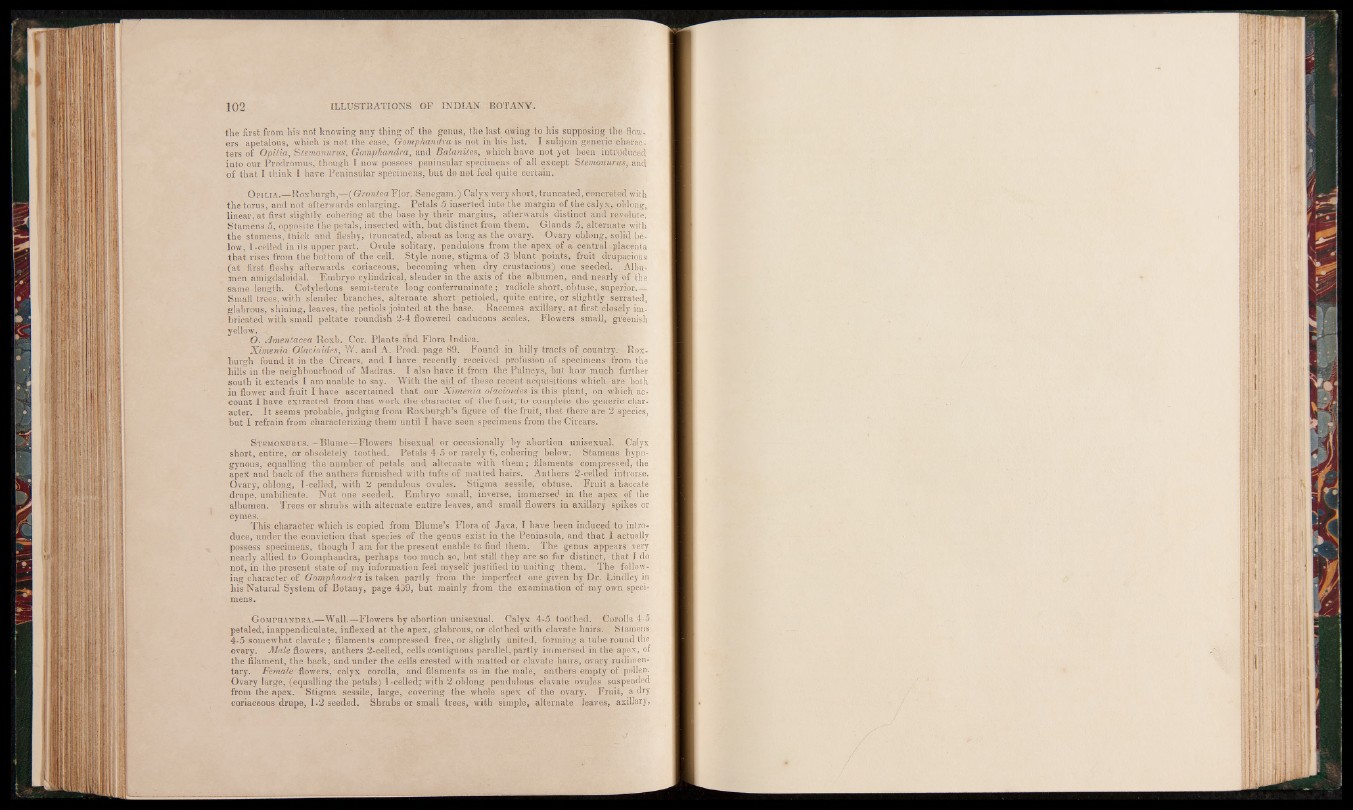
the first from, his not knowing any thing of the genus, the last owing to his supposing the flowers
apetalous, which is not the case, Gomphandra is not in his list. I subjoin generic characters
of Opilia, Stemonurus, Gomphandra, and Balanites, which have not yet been introduced
into our Prodrom us,'though I now possess peninsular specimens of all except Stemonurus, and
of that I think I have Peninsular specimens, but do not feel quite certain.
Opilia.—Roxburgh,—(Gmntea Flor. Senegam.) Calyx very short, truncated, doncreted with
the torus, and not afterwards enlarging. Petals 5 inserted into the margin of the calyx, oblong,
linear, at first slightly cohering at the base by their margins, afterwards distinct and revolute.
Stamens 5, opposite the petals, inserted with, but distinct from them. Glands 5, alternate with
the stamens, thick and fleshy, truncated, about as long as the ovary. Ovary oblong, solid below,
1-celled in its upper part. Ovule solitary, pendulous from the apex of a central placenta
that rises from the bottom of the cell. Style none, stigma of 3 blunt points, fruit drupacious
(at first, fleshy afterwards coriaceous, becoming when dry crustacious) one seeded. Albumen
amigdaloidal. Embryo cylindrical, slender in the axis of the albumen, and nearly of the
same length. Cotyledons semi-terate long conferruminate ; radicle short, obtuse, superior.—
Small trees, with slender branches, alternate short petioled, quite entire, or slightly serrated,
glabrous,'shining, leaves, the petiols jointed at the base. . Racemes axillary, at first closely imbricated
with small peltate roundish 2-4 flowered caducous scales. Flowers small, greenish
yellow.
O. Amentacea Roxb. Cor. Plants and Flora Indica.
Ximenia Olacioides, W. and A. Prod, page 89. Found in hilly tracts of country. Roxburgh
found it in the Circars, and I have recently received profusion of specimens from the
hills in the neighbourhood of Madras. I also have it from the Pulneys, but how much further
south it extends I am unable to say. With the aid of these recent acquisitions which are both
in flower and fruit I have ascertained that our Ximenia olacioides is this plant, on which account
I have extracted from that work the character of the fruit7*to complete the generic character.
It seems probable, judging from Roxburgh’s figure of the fruit, that there are 2 species,
but I refrain from characterizing them until I have „seen specimens from the Circars.
Stemonurus. — Blume—Flowers bisexual or occasionally by abortion unisexual. Calyx
short, entire, or obsoletely toothed. Petals 4-5 or rarely 6, cohering below. Stamens hvpo-
gynous, equalling the nnmber of petals and alternate with them; filaments compressed, the
ape! and back of the anthers furnished with tufts of matted hairs. Anthers 2-celled introrse.
Ovary, oblong, I-celled, with Z pendulous ovules. Stigma sessile, obtuse. Fruit a baccate
drupe, umbilicate. Nut. one seeded. Embryo small, inverse, immersed in the apex of the
albumen. Trees or shrubs with alternate entire leaves, and small flowers in axillary spikes or
cymes.
This character which is copied from Blume’s Flora of Java, T have been induced to introduce,
under the conviction that species of the genus exist in the Peninsula, and that I actually
possess specimens, though T am for the present enable to find them. The genus appears very
nearly allied to Gomphandra, perhaps too much so, but still they are so far distinct, that I do
not, in the present state of my information feel myself justified in uniting them. The following
character of Gomphandra is taken partly from the imperfect one given by Dr. Lindley in
his Natural System of Botany, page 439, but mainly from the examination of my own specimens.
Gomphandra.—Wall.—Flowers by abortion unisexual. Calyx 4-5 toothed. Corolla 4-5
petaled, inappendiculate, inflexed at the apex, glabrous, or clothed with clavate hairs. Stamens
4-5 somewhat clavate; filaments compressed free, or slightly united, forming a tube round the
ovary. Male flowers, anthers 2-celled, cells contiguous parallel, partly immersed in the apex, of
the filament, the back, and under the cells crested with matted or clavate hairs, ovary rudimentary.
Female flowers, calyx corolla, and filaments as in the male, anthers empty of pollen.
Ovary large, (equalling the petals) 1-celled; with 2 oblong pendulous clavate ovules suspended
from the apex. Stigma sessile, large, covering the whole apex of the ovary. Fruit, a dry
coriaceous drupe, 1-2 seeded. Shrubs or small trees, with simple, alternate leaves, axillary,